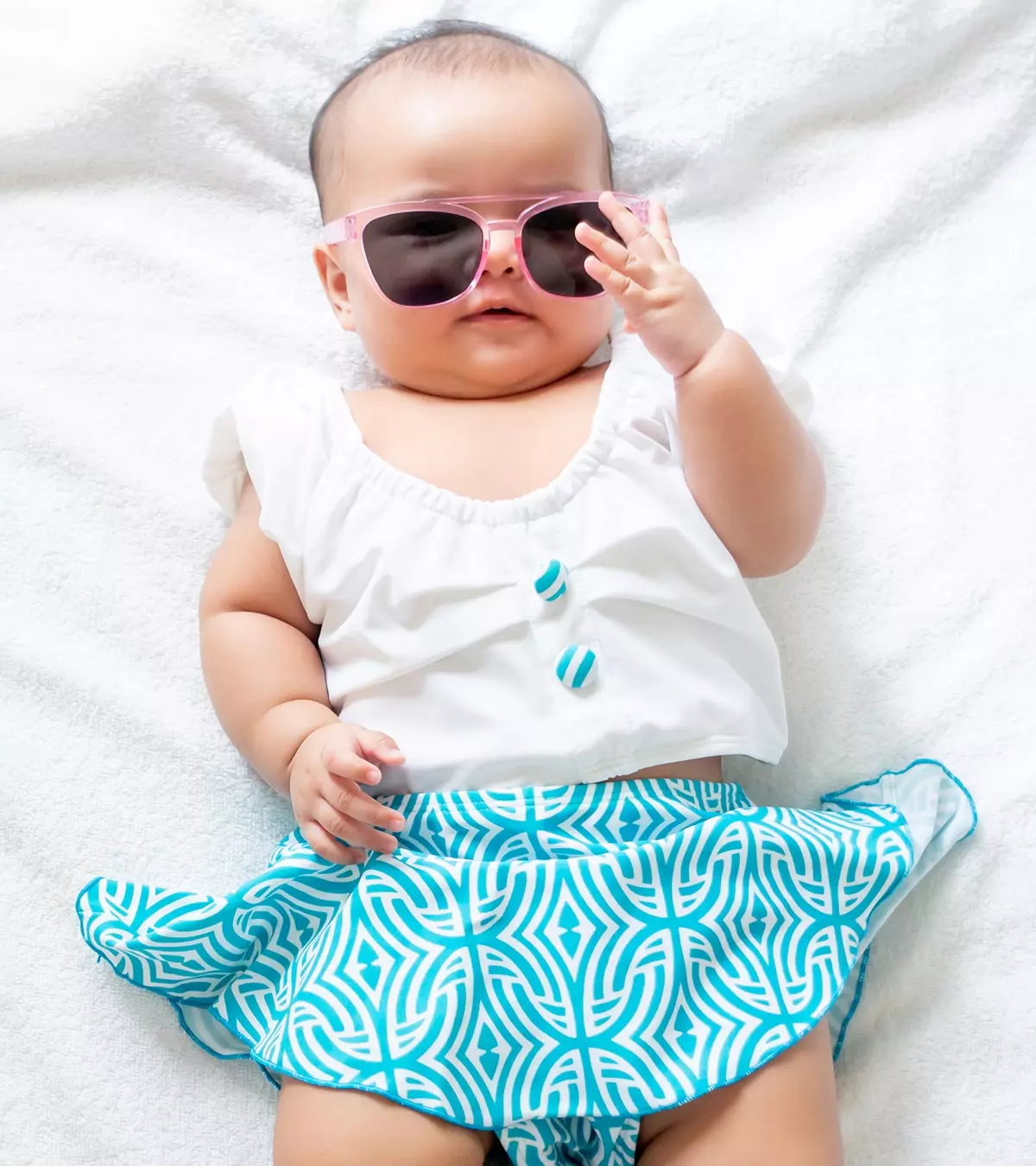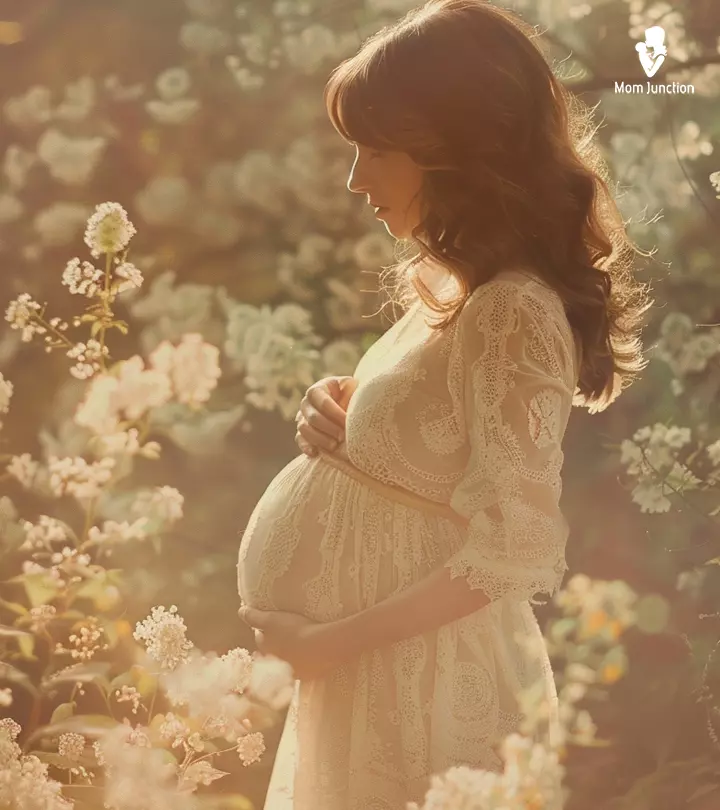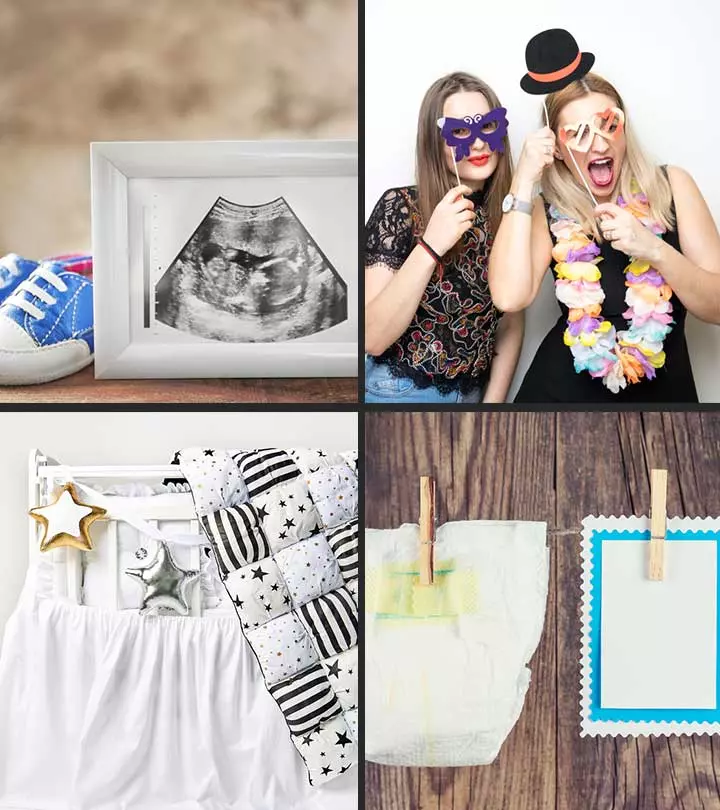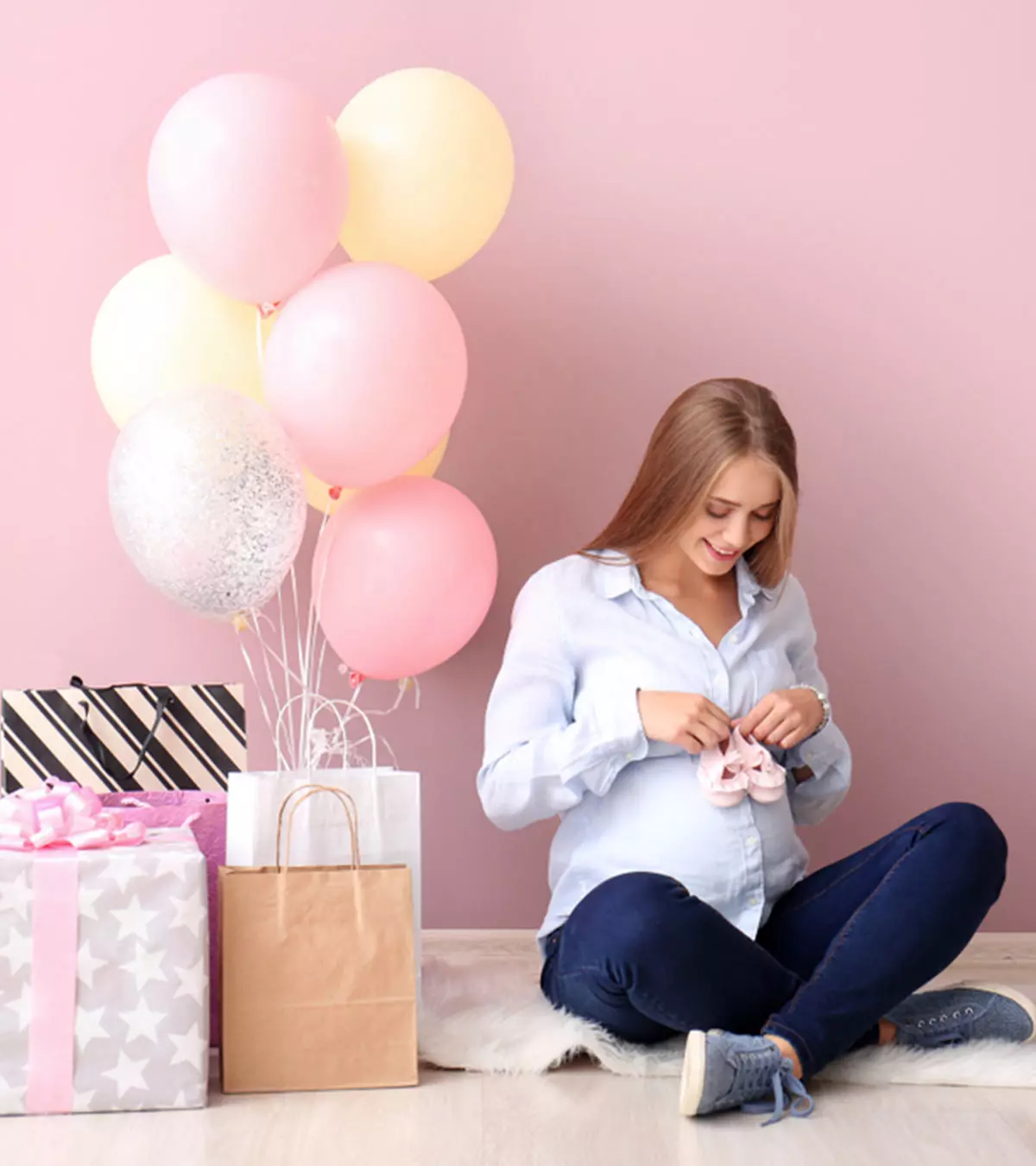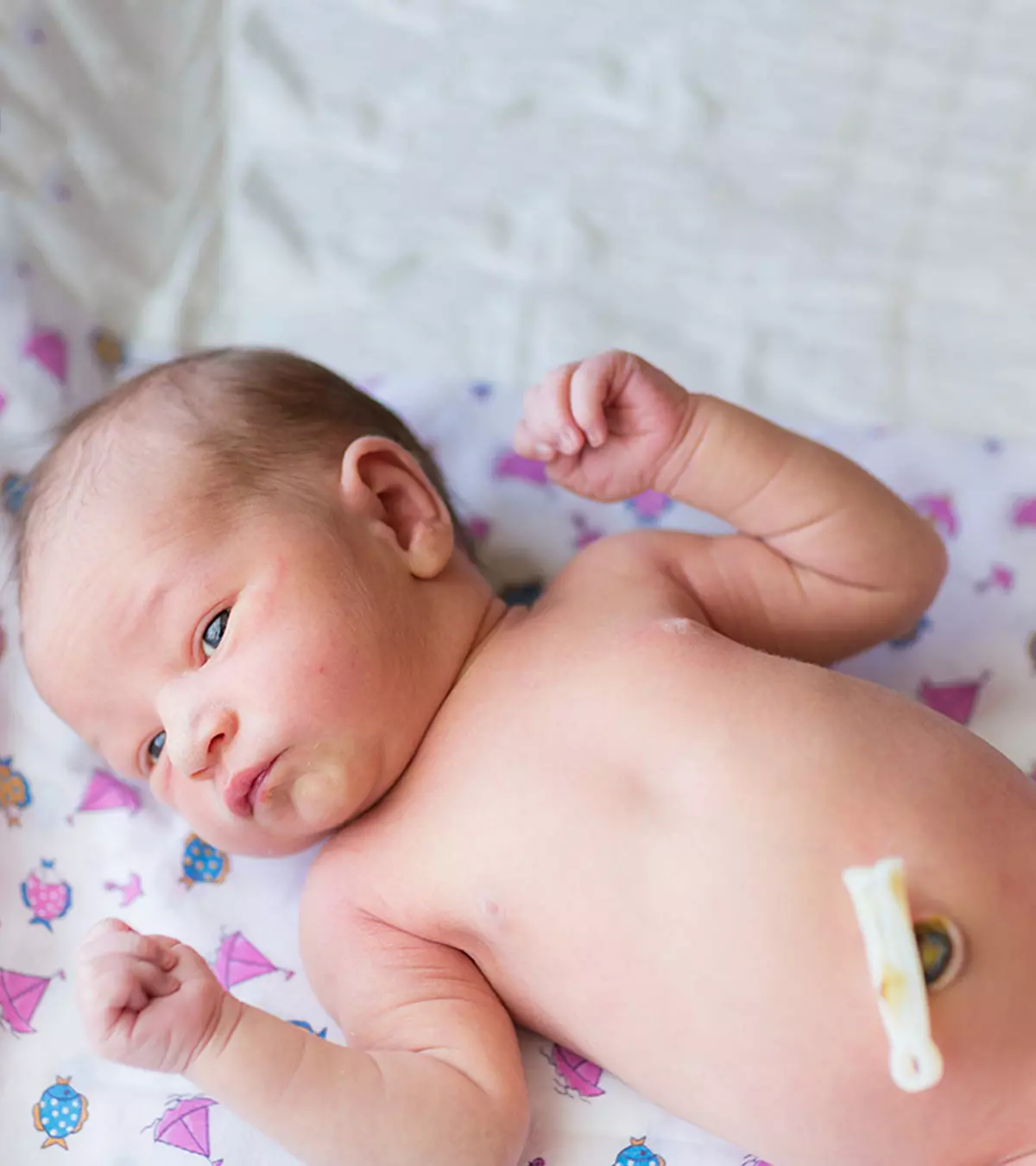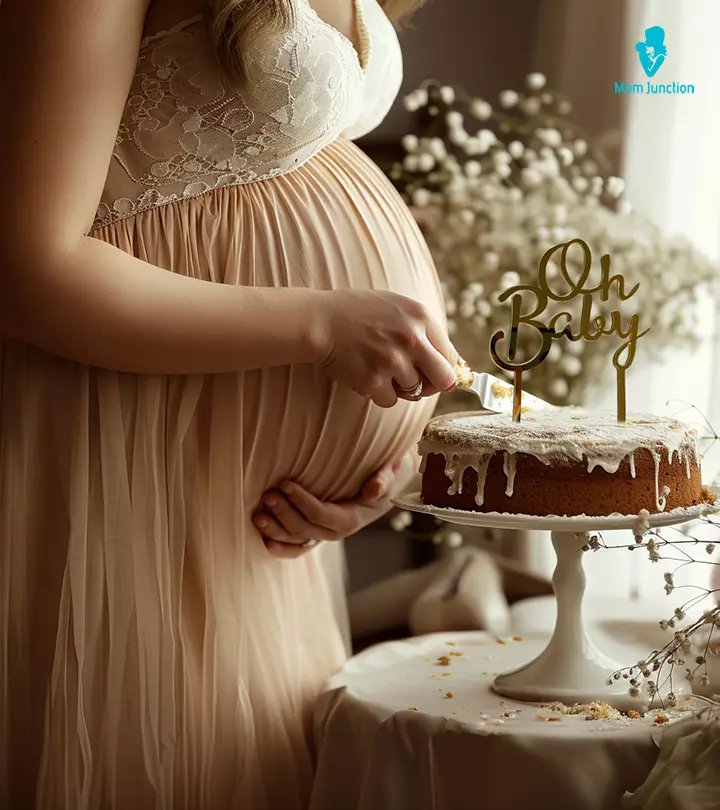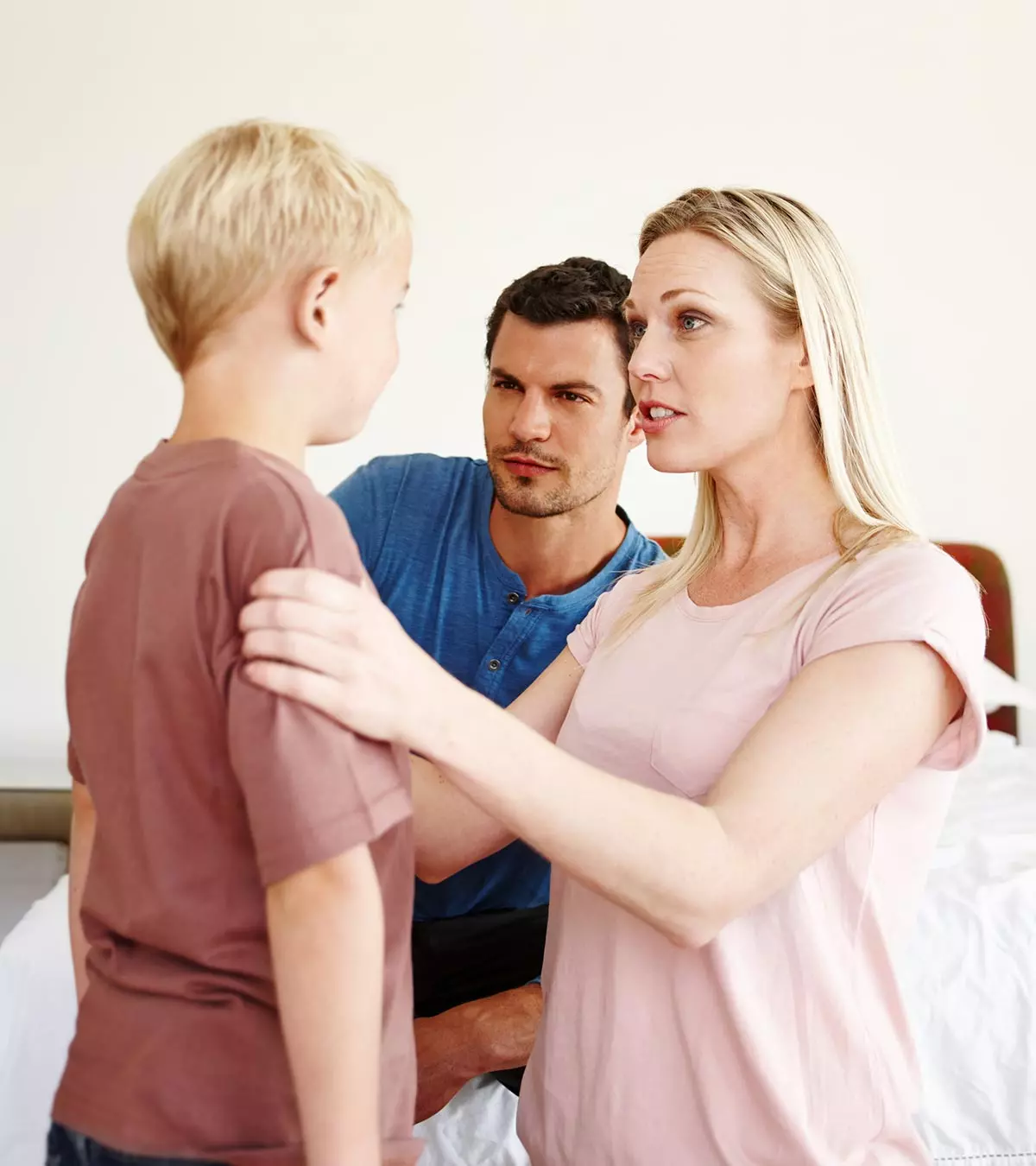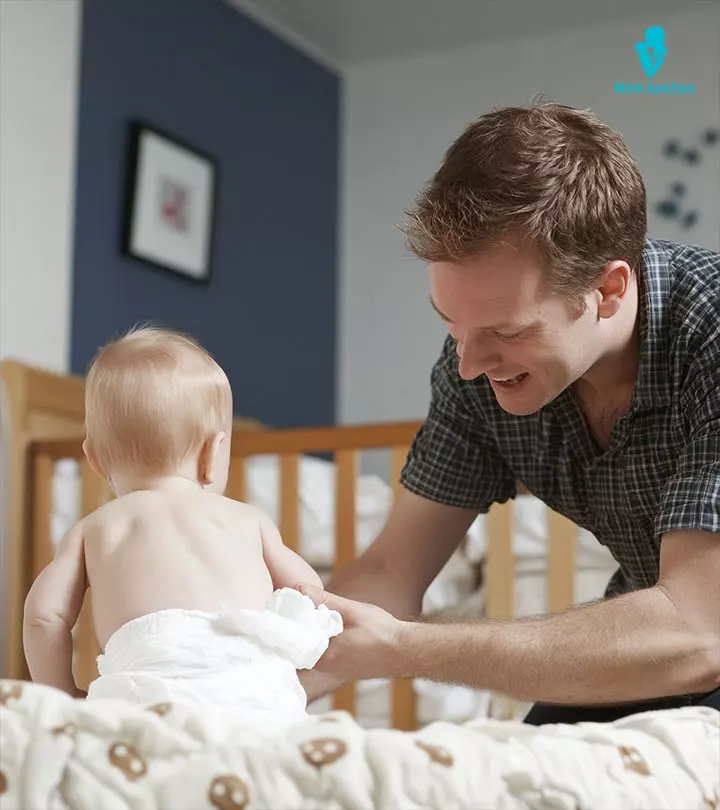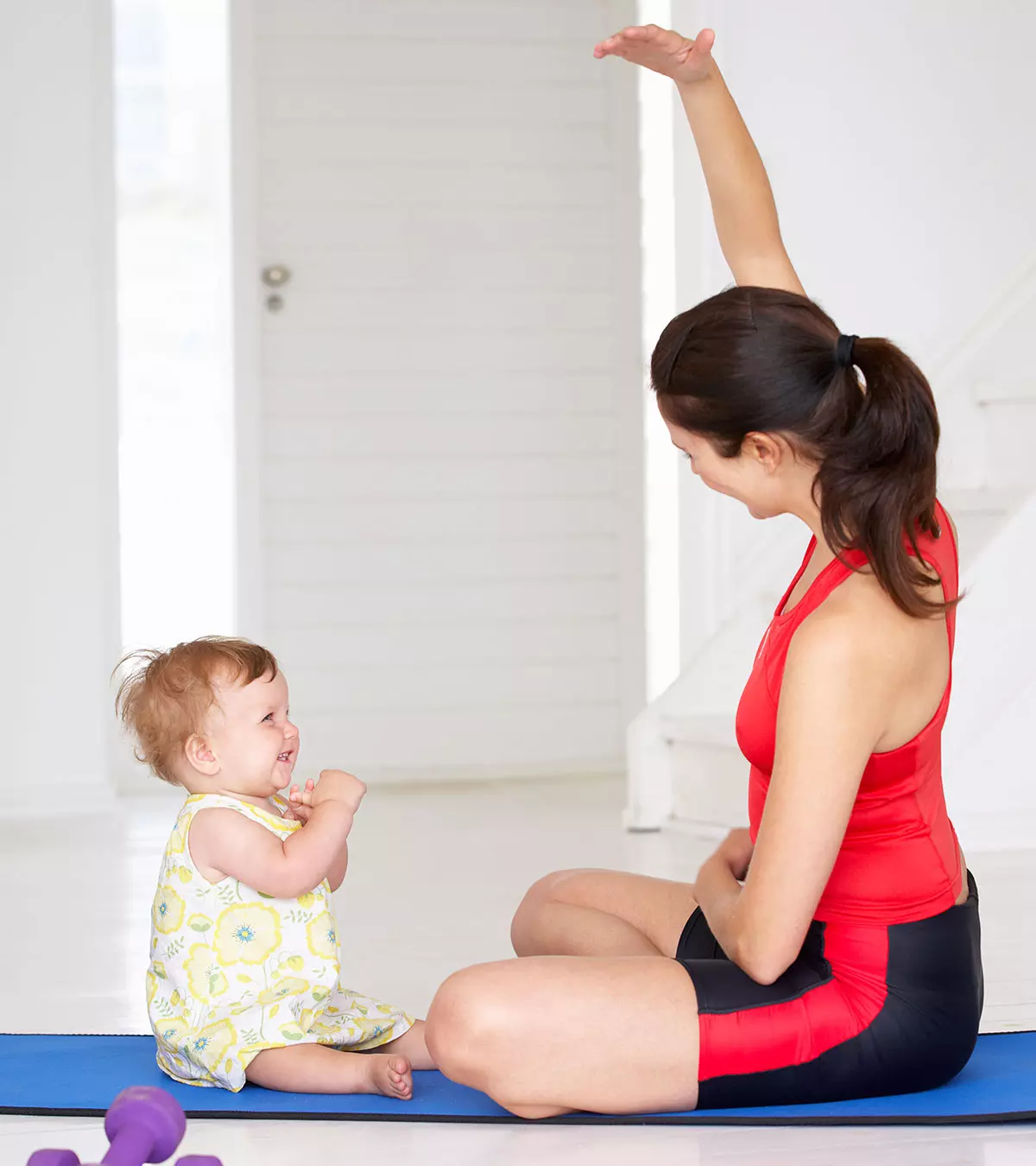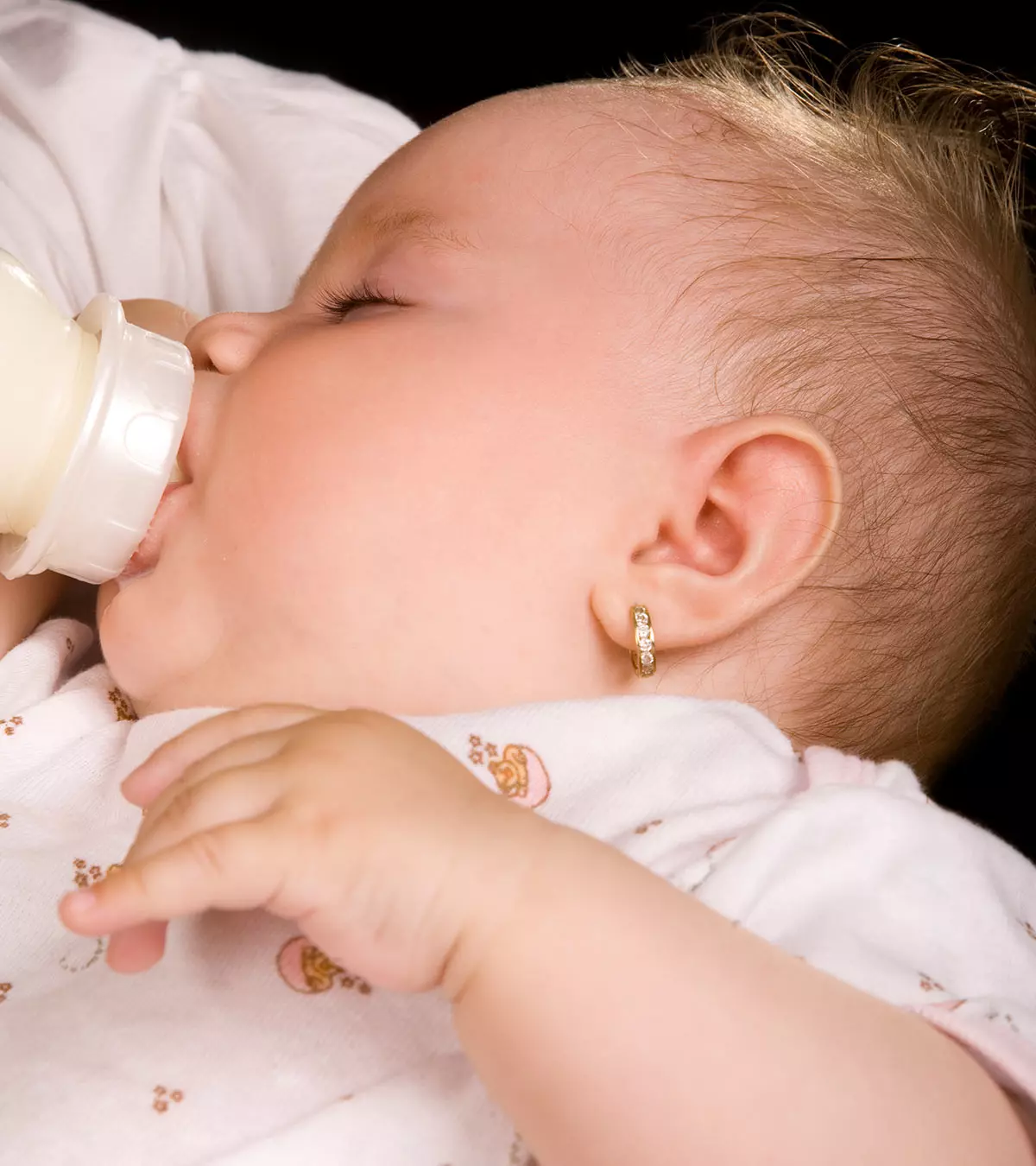
Image: iStock
Piercing the ears of babies is a prevalent practice in many cultures worldwide. In Hispanic, Indian, and some African communities, it’s often viewed as a rite of passage or a way to add beauty. In certain cultures, the ears of boys are also pierced when they are still babies. However, as a parent, you may be unsure if ear piercing is safe for babies or when to pierce baby ears. Since the practice is painful, parents often find it difficult to decide whether or not they should get their baby’s ear pierced. Moreover, many different perspectives exist around the world about ear piercing. In certain nations, there have been petitions against baby ear piercings. However, in certain others, it is considered traditional and unusual if it is not done. In this post, we answer some frequently asked questions regarding ear piercings for babies, including when and where you can get your baby’s ear pierced, how it is done for babies, and how to prepare your baby for it. The article also offers advice on coping with any infections that babies may contract and recommendations on the type of earrings your infant could wear.

Key Pointers
- The AAP recommends waiting until a child turns two before piercing their ears.
- It is important to prioritize the child’s health and comfort before the procedure.
- Choosing an experienced piercer who follows necessary safety and hygiene measures is crucial.
- After the procedure, the ears should be regularly cleaned and protected from exposure to dust to prevent allergies and infections.
- Additional aftercare instructions include avoiding touching the earrings, keeping the ears clean and dry, and removing the earrings before the child goes to sleep.
When Can You Get Your Baby’s Ears Pierced?
According to the American Academy of Pediatrics (AAP), there is no fixed age for piercing your child’s ears, and regardless of the age, ear piercing is not risky as long as it is done correctly and hygienically (1).
Some parents get it done when the baby is just 12 days old, while some prefer to wait until their first birthday. Some believe that infants and babies are less likely to play with or touch their ear piercings. However, they may be more susceptible to allergies and infections. Experts at Indiana University Health suggest waiting for at least three months before getting the baby’s ears pierced to reduce the risk of infections, as the baby will have received their first set of vaccinations by then (2). Therefore, the age may vary, and the decision of when to pierce a baby’s ears may depend on factors such as personal preferences, individual needs, and the baby’s health condition.
The American Academy of Pediatrics (AAP) recommends waiting until the child is old enough to take care of the pierced ear. In practical terms, this usually means around the age of two years (3). Two years is a suitable age for ear piercing due to several factors: Your baby’s body is less prone to allergies, they are old enough to understand instructions, and the skin is still soft but not delicate like before. By this age, most primary immunizations, including tetanus, would be done, thereby reducing the risk of blood-borne infections (3).
A study has illustrated that children are least prone to keloids – an overgrowth of scar tissue – when the piercing is done between one and ten years of age (4).
Eventually, you may choose when to get your baby’s ears pierced. If you proceed with the decision of getting your baby’s ears pierced a bit early, then you must get it done at the right place.
Where Can You Get Your Baby’s Ears Pierced?
Some people get it done at their local jeweler while some prefer going to a medical professional, who also practices ear piercing.
There is no restriction here provided the person is a professional, and the place is aseptic.
The tools used for the job must be sterile. Do keep in mind that ear piercing is different for babies and adults. Therefore, do some research and find a place that has a decent reputation of getting the baby piercing done. Do not simply select a random place. Give preference to pediatricians and medical professionals who do ear piercing for a fee, since they are educated about safety guidelines.
Ear piercing can be smooth if you have a skilled technician, as they complete it quickly and with minimal discomfort. Recounting her experience of getting her daughter’s ears pierced, Lisa Daniels, a mother and blogger, says, “The technician made a dot on each ear to mark the exact spot to insert the earrings. She took extra care to make sure they were even. We picked pretty little diamond studs, and then I watched as the technician meticulously cleaned all of her piercing equipment, Lilly’s ears, and the earrings. I felt confident in the cleanliness of the procedure.
“The technician asked another worker to assist with the piercing, and she counted… ‘1…2…3.’ The piercing guns clicked in each ear simultaneously, and then it was over. As expected, Lilly started crying the moment the earrings were in. I cuddled her, ‘shushed’ her, and the crying was over as quickly as it started (i).”
How Is The Ear Piercing Done For Babies?
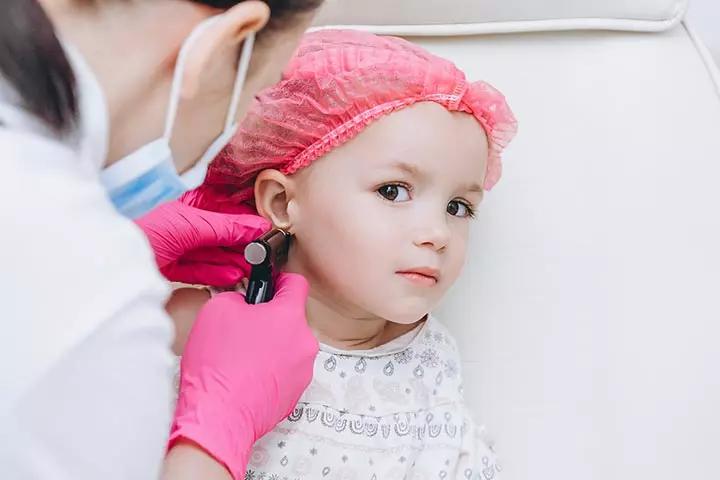
The baby piercing process can be similar to that for adults. Here is a stepwise breakdown of the procedure:
Step 1: The technician/doctor disinfects the piercing site by cleaning it with alcohol or any other skin disinfectant. To keep things hygienic and professional, he/she must wear surgical gloves.
Step 2: Piercing can be done through needle-based piercers or piercing guns. It depends on what the parent prefers and what the ear piercing professional recommends. Both cause a bit of pain but only when the piercing is in the process that is a few minutes.
Step 3: The holes will then be filled with gold-post earrings or studs, which act as a placeholder to prevent the hole from closing. Gold or sterling silver could be the metals of choice in jewelry since it is less likely to cause infections and/ or allergic reactions (2) (5). It does not exacerbate the existing redness and mild inflammation. Make sure the gold is at least 14 karat. An alternative to gold is surgical steel, which is free of nickel. Gold-plated surgical steel earrings are also good.
Step 4: The technician/doctor will place earring backs behind the earring to secure the earring in its place.
The bottom of the ear lobes is considered the ideal location for piercing. Spots other than the conventional ear lobe are not meant for piercing during childhood. Pediatric experts do not recommend body piercing as it increases the risk of infections of the skin or cartilage (5) . Therefore, stick to the lower ear lobe; it is easier and less painful due to an absence of a bone in that region.
Megha, a mother to twin daughters, says, “I was terrified about getting my daughter’s delicate little ears pierced. I was worried about how much pain it would cause them, whether there would be dreadful results like uneven holes, and if there would be post-piercing complications like infection and keloids. However, my fears were unwarranted as we selected an experienced piercer to do the job in a clean environment. I had taken along alcohol swabs and local anesthetic spray. The position of the hole was first marked with a pen, the earrings were selected beforehand, the area was disinfected, an anesthetic was applied, and within a minute, a quick gunshot did the job. The girls did cry but only for a minute, after which they went back to being their usual smiley selves (ii).”
The process needs preparation from your side, so that it does not become hectic later.
How To Prepare The Baby For Ear Piercing?
Some simple preparations can make the process of ear piercing for kids and babies smooth:
- Your child should be in good health to reduce the chances of irritability and improve their tolerance during the process. If the baby is sick or just faced a bout of illness, then postpone the plan to a later date. In some rare instances, the child may have an increased risk of infection if they have congenital heart disease (6).
- Carry your baby’s favorite toys, pacifiers, or other interesting stuff to distract them while piercing. They come in handy when they get cranky.
- On the big day, let your child wear buttoned clothes that can be removed without pulling the dress over the head. This can mitigate the chance of an accidental tug at the ears.
- During the piercing process, hold the child firm yet gentle. They are quite likely to move after the first ear is pierced. Hold the baby still and cajole them with soothing words to get the second one right on the mark.
- Praise your child for being brave and cooperative throughout the procedure. Give them a special treat later.
Once the piercing is done, you need to choose earrings that are safe and convenient for your little one.
What Are The Types Of Earrings A Baby Can Wear?
Babies should only wear post-type small earrings that fasten securely in the hole. Choose earrings that have a soft fastener at the rear, which is less likely to prick the baby’s skin. These earrings are also lightweight.
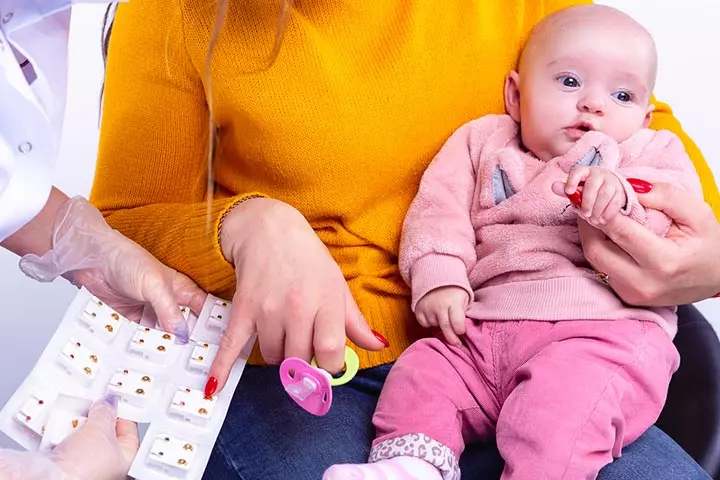
- Never select dangling earrings for your baby. Your baby can accidentally tug at them, thus hurting herself.
- Also, stay away from earrings with large and sharp projections at the rear, which may hurt the baby while sleeping. Tend to the piercing site with care.
 Experts say
Experts sayPrecautions To Take After Piercing
It will take about four to six weeks for the holes to heal. Therefore, you need to prioritize good ear care for your little one. During this phase, check for any infections and follow the below-mentioned ear piercing aftercare tips:
- As mentioned above, swap the earrings once in a week from one ear to another. Every time you remove an earring, clean it with a cotton swab dipped in a disinfectant. Pediatrician Dr. Alyssa Swick, MD, from Riley Hospital for Children at Indiana University Health suggests, cleaning your baby’s ears for about six weeks after piercing and avoiding earring changes during this period (2).
- Tend the pierced site with clean hands. Wash and dry your hands thoroughly before you touch your baby’s ears.
- Dab some disinfectant twice a day for about 45 days after the piercing is done, to prevent the proliferation of bacteria. Also, wash the area around the ears only with baby-safe antibacterial soap.
- Keep your baby away from dust since it can be a carrier of bacteria.
- Prevent your baby from tugging their ears.
You are aware that pierced ear holes are prone to infection. Therefore, keep checking for any signs and nip them in the bud. The Seattle Children’s Hospital adds that infection may occur even after the pierced hole has healed if (7):
- Earrings and posts are not cleaned regularly.
- Earrings are too tight and not taken out at night.
- Any scratch or tear occurs in the ear channel due to inserting the post at a wrong angle.
- Post contains nickel that may cause itching and allergy.
 Caution
CautionWhat Are The Symptoms Of Pierced Hole Infection?

Look out for these early warning signs (5):
- Chronic redness in the ear: Your baby will have some redness in the region for a few days, but if it continues for weeks, then it could be a symptom of a mild infection.
- Pus or other fluid oozing from the pierced site: Pus is formed due to an acute accumulation of white blood cells. If there is pus, then there is surely an infection. A mild infection may drip a clear, colorless liquid.
- Red blisters: These blisters could be red or maroon in color. They are tender, and your baby may squeal when they are touched, indicating that they are painful.
- Large single blister: If you notice a single large blister close to the pierced hole, then it could be a keloid, an overgrowth of scar tissue. Keloids usually have a tendency to get infected.
- Fever: An infection could manifest through a fever. If your baby develops a fever a few hours or days after ear piercing, then you must take them to the doctor.
Understanding the reasons for infection can help you take precautions to avoid them.
What Causes Pierced Ear Infection?
The pierced hole in the ear is fundamentally a wound, and just like any other wound, it can be prone to infection from a host of bacteria naturally present on the skin or in the air. Several factors that can aggravate the chances of infection (7):
- Poor maintenance of the pierced area: This includes not swapping the earrings or not cleaning them properly in case you swap them. Infection also happens if you fail to apply the disinfectant.
- Exposing the baby to bacteria: Bacteria is found everywhere from the dust found at home to the park the little one goes to play. If you do not take the necessary measures to prevent exposure, then the piercing may get infected.
- Tight, uncomfortable earrings: Tight earrings press the hole tightly, slowing down the healing process. Also, it restricts air circulation around that area.
- Constant tugging at the ears: If your child tugs the ears, then it can cause an accidental laceration of the piercing, which can get infected.
- Even if all the instructions are followed there is always a risk of infection if the skin is pierced. Do not postpone getting help if there is infection. Let your healthcare worker assess if you are worried.
Your baby looks beautiful with those pretty earrings and you will not want that beauty to be disturbed by an infection. So, what can you do about it?
 Quick tip
Quick tipTreatment For Infection
If you suspect an infection, then apply some disinfectant using a cotton swab and take your baby to the doctor. Do not attempt to treat the infection on your own. Certain remedies, such as hot compresses or running saline water on the ear, work for adults but can be harmful to the delicate skin of the baby. You may unintentionally compound the infection. A medical professional is the right person to assess the infection and give the relevant medication. For most mild infections good cleaning and a topical antibiotic ointment will be enough to treat. In some cases, oral antibiotics and/ or other treatments might be needed.
Frequently Asked Questions
1. Can my baby wear clip-on earrings instead of getting their ears pierced?
Clip-on earrings are a temporary alternative to pierced earrings and can be a good option for parents who are unsure if they want to commit to piercing their baby’s ears. But parents need to exercise caution as babies may remove clip-on earrings and put them in their mouth, leading to a serious choking hazard.
2. How can I prevent my baby from pulling on their earrings?
To prevent your baby from pulling on their earrings, use specially designed earring backs that are more difficult to remove, or try distracting them with toys or other activities.
3. Should I pierce both ears at the same time or one at a time?
It is generally recommended to pierce both ears at the same time to minimize the overall discomfort and make the healing process easier. However, this decision ultimately depends on the preference of the parents and the professional performing the piercing.
4. How much does it cost to pierce a baby’s ears?
The cost of piercing a baby’s ears can vary depending on the location, the professional’s experience and qualifications, and any additional services provided. It is important to research and compare the prices of different professionals before deciding.
Now that you know when to pierce a baby’s ears, prepare your child for the activity in advance. If your child is old enough to understand the process, it may help to involve them in choosing an earring. Ensure only to get the process done by a certified piercer or a medical professional trained in pediatric piercings. Follow the safety precautions to prevent the spread of any infection. Proper care is essential for healing your child’s ear sooner. You could then focus on finding the right earring to make your little one appear more adorable.
Infographic: General Care For Pierced Ears
Having a pierced ear requires long-term attention and care. It involves occasional cleaning and other protective measures to prevent the piercing from getting infected or pus-filled. So keep this infographic handy and note down the tips to maintain a healthy ear piercing for your baby. Illustration: Momjunction Design Team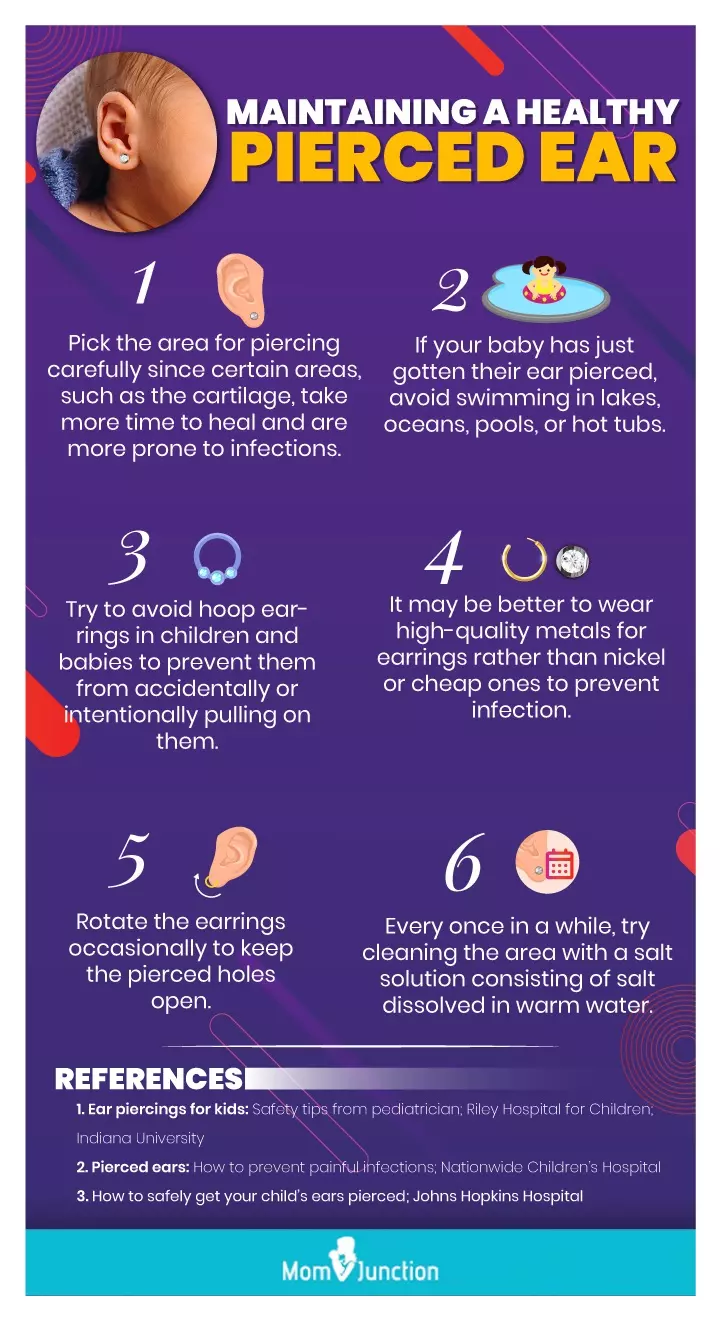
Illustration: Baby’s Ear Piercing: Right Age And 9 Things To Know About It

Image: Dall·E/MomJunction Design Team
Personal Experience: Sources
MomJunction articles include first-hand experiences to provide you with better insights through real-life narratives. Here are the sources of personal accounts referenced in this article.
i. Baby Ear Piercing: Our Experience.https://threeladiesandtheirbabies.wordpress.com/2013/09/20/baby-ear-piercing-our-experience/
ii. Snapshots of my India trip 2015.
https://meinblogland.blogspot.com/2015/06/snapshots-of-my-india-trip-2015.html
References
- Avoiding Infection After Ear Piercing
https://www.healthychildren.org/English/health-issues/conditions/ear-nose-throat/Pages/Avoiding-Infection-After-Ear-Piercing.aspx - Ear Piercing For Kids: Safety Tips From a Pediatrician
https://www.rileychildrens.org/connections/ear-piercing-for-kids-safety-tips-from-a-pediatrician - The Risks of Infant Ear Piercing
https://www.hopkinsmedicine.org/news/articles/2015/03/the-risks-of-infant-ear-piercing - Joshua E. Lane, et al., (2005), Relationship Between Age of Ear Piercing and Keloid Formation.
https://publications.aap.org/pediatrics/article-abstract/115/5/1312/67513/Relationship-Between-Age-of-Ear-Piercing-and - Body Piercing.
https://www.akronchildrens.org/kidshealth/en/teens/body-piercing-safe.html - F Cetta et al. (1999) Piercing and tattooing in patients with congenital heart disease: patient and physician perspectives.
https://pubmed.ncbi.nlm.nih.gov/10195798/ - Ear Piercing Symptoms
https://www.seattlechildrens.org/conditions/a-z/ear-piercing-symptoms/
Delve into the realm of piercing your baby’s ears safely by watching this video, exploring the nuanced realm of risks and benefits associated with this choice.
Community Experiences
Join the conversation and become a part of our nurturing community! Share your stories, experiences, and insights to connect with fellow parents.
Read full bio of Dr. Wayne Hough
Read full bio of Rohit Garoo
Read full bio of Rebecca Malachi
Read full bio of Vidya Tadapatri






